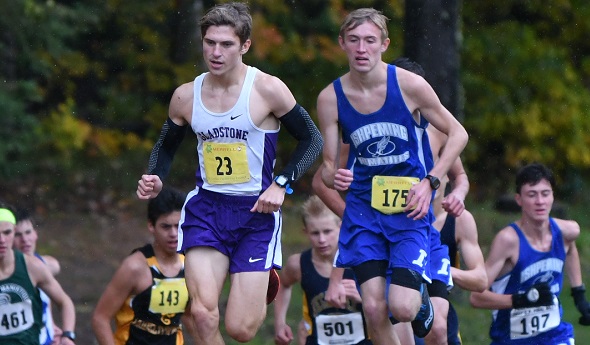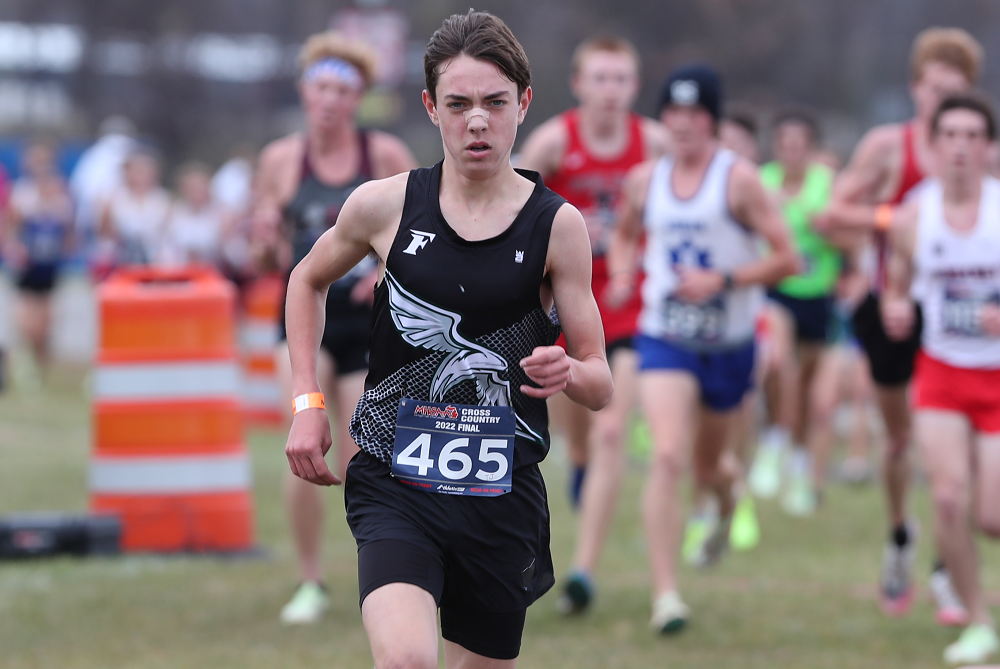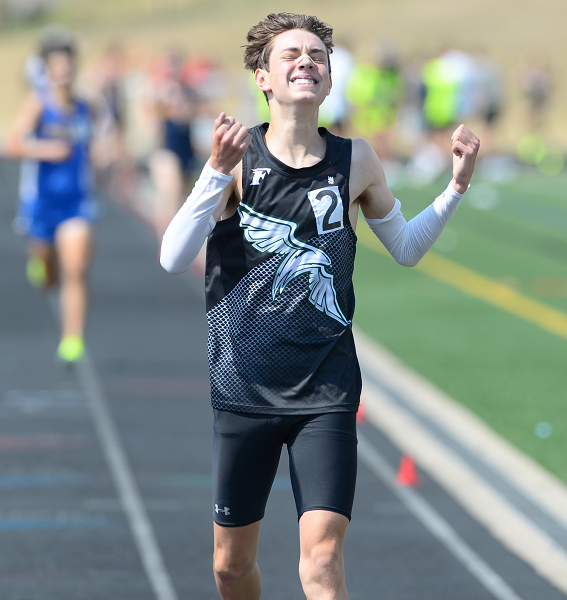
Preview: Powers Prepared to Surge
October 19, 2018
By Geoff Kimmerly
Second Half editor
Marquette and Ishpeming have combined for 40 Upper Peninsula boys cross country championships over the years.
They’re predicted to add to that total this weekend.
The Redmen and Hematites are among teams that enter Saturday’s Upper Peninsula Boys Cross Country Finals top-ranked in their respective divisions. Chassell also is a favorite, running for its eight MHSAA championship in this sport.
Races at Pictured Rocks Golf Course in Munising begin Saturday with the Division 1 boys at 11 a.m. and finish with the Division 3 girls at 1:30 p.m. Check back Saturday evening for coverage, and see below for more teams and individuals to watch.
Division 1
Reigning champion: Houghton
2017 runner-up: Marquette
2018 top-ranked: 1. Marquette, 2. Houghton, 3. Gladstone.
Marquette has won the most U.P. Finals titles, 22, and is favored to win its first since 2014. The Redmen finished 15 points behind Houghton last season as they combined to take six of the top 10 team places – although five of those runners graduated this spring and the sixth isn’t running this weekend. The Redmen did win the Great Northern Conference meet last week with five of the top 10 finishers led by senior Mathurin Gagnon, who took 22nd at last season’s Final. Houghton finished second in the Western Peninsula Athletic Conference and returns senior Clayton Bulleit, who was 18th at last season’s Final, and junior Joe Wood was the individual West-PAC champ. Gladstone, led by individual favorite Adam Bruce, was second at the GNC taking the top two spots and three of the top six.
Individuals: Seven of the top 20 from last season’s Final are back this weekend, and Bruce recently won both the GNC and Mid-Peninsula Conference meet championships. Senior teammate Jake Strasler was eighth last season and should help keep the Braves in the team title hunt. Negaunee junior Eric Anderson also returns after finishing ninth, and Sault Ste. Marie brings back three top-20 finishers from a year ago – junior Kaaleb Ranta, sophomore Hunter Walther and senior Jakob Hopkins.
Division 2
Reigning champion: Gogebic (Wakefield-Marenisco/Bessemer)
2017 runner-up: Ishpeming
2018 top-ranked: 1. Ishpeming, 2. Gogebic, 3. Ironwood.
Last season’s Final was a two-team race with Gogebic and Ishpeming placing nine of the top 10 runners. Ishpeming’s top seven all placed among the top 17, and five of those runners return led by individual champion and now-senior Spencer Giroux, junior Jonah Broberg (fifth) and senior Devin Tasson (10th). Gogebic placed six among the top 14 a year ago, and four return including seniors Uriah Aili (third), Devon Byers (fourth) and Cade Mazzon (sixth). Ironwood is led by senior Nick Niemi, who came in eighth last season, and junior David Collins is returning after finishing 16th. Aili, Niemi and Giroux finished in that order in the top three spots and all within two seconds of each other at the Houghton Invitational on Oct. 4.
Individuals: The front pack should have a familiar look with 14 of last season’s top 20 running this weekend. In addition to the many listed above, watch for Ishpeming sophomores Jordan Longtine (12th last season) and Silas Broberg (17th), Gogebic junior Adam Mazurek (14th), Newberry sophomore Ephram Evans (15th) and senior Chase Canfield (19th) and Manistique junior Alex Misniakiewicz (20th).
Division 3
Reigning champion: Brimley
2017 runner-up: Chassell
2018 top-ranked: 1. Chassell, 2. Dollar Bay, 3. Rock Mid-Peninsula.
This was another two-team race last season – so much so that it came down to a sixth-runner tiebreaker. Chassell won three straight titles from 2014-16 and is expected to rise to the top spot again returning three of last season’s top 13 – seniors Ben Tuomi (third) and Kurtis Kytta (sixth) and freshman Daba Holmes (13th). Brimley was left out of the final rankings but returns three of the top 11 finishers – reigning individual champion and now-junior Austin Plotkin plus sophomore Cameron Hoonstra (eighth) and senior Hunter Lipponen (11th).
Individuals: Cedarville junior Thomas Bohn was the runner-up a year ago and also is back, meaning the top three from last season’s race all return as 10 of the top 16 are expected to run Saturday. Also look out for Powers North Central senior Griffin Johnson (ninth last year), Rudyard junior Payton Cheney (10th) and Rapid River junior Azariah Hernandez (16th).
PHOTO: Gladstone’s Adam Bruce, left, and Ishpeming’s Spencer Giroux lead the pack at the Mid-Peninsula Conference championship race Oct. 8. (Photo by Cara Kamps.)

Freeland's Hansen Not Focused on Joining All-Time Greats - But On His Way
By
Paul Costanzo
Special for MHSAA.com
September 29, 2023
The goal written on Matt Kaczor’s Post-It Note was sub-15 minutes, 15 seconds. That’s what the Freeland cross country coach was hoping for from star runner TJ Hansen during his junior season.
 Kaczor tore it up after seeing Hansen run a single race this fall.
Kaczor tore it up after seeing Hansen run a single race this fall.
“Knowing what he did over the summer and where he was at, seeing what his 1,600 (meter) and his mile got down to, I had a feeling he could get under 15:30 quickly,” Kaczor said. “After the first race, I looked at my assistant and was like, ‘I’ve gotta rip up that Post-It Note. I don’t think our goal is on the level of where he’s at right now.’ At first, it was break 15:15. Once I saw him race at the Under the Lights (on Aug. 18 at St. Johns), I was like, ‘Yeah, he’s going sub 15.’”
Hansen ran 15:39.6 in that first race, and on Sept. 7, in Shepherd, he ran 15:13.9 to meet the goal written on the now-shredded Post-It Note.
This past Saturday, he ran 15:03.7 at the Cadillac Veterans Serving Veterans Invitational. It’s the fastest time recorded in Michigan this year, and a signal that Kaczor might be filling out a new Post-It Note before the season is out.
“The sub-15 barrier, that’s been something on my mind for a while,” Hansen said. “Now that I’m edging closer and closer to that, it’s been exciting. With how heavy my training has been, I wouldn’t expect (to have run this fast this early). Being able to run the times I am really paints the picture for what’s ahead.”
Hansen came into the season already regarded as one of the elite distance runners in the state. He won the 3,200 meters at the MHSAA Lower Peninsula Division 2 Track & Field Finals this past spring. He’s also finished all-state (12th and fifth, respectively) the past two seasons at the LPD2 Cross Country Finals.
His current trajectory, however, would put his name near some of the state’s all-time greats. But that’s not something Hansen is focusing on.
“I really don’t like to compare myself to others,” he said. “I don’t focus on that. I try to be the best TJ Hansen that I can be. The best version of myself.”
Focusing on himself is almost necessary for Hansen, as he’s spending a lot of time during his races running by himself.
At each of the big events Freeland has run in this season, Hansen has finished at least 20 seconds ahead of his nearest competitor. That includes all divisions of the Duane Raffin Festival of Races in Holly.
In Cadillac, where Hansen ran his current best time, he was a full minute ahead of the rest of the field.
 “He’s just a special athlete,” Kaczor said. “I can’t see Freeland having someone like this in a while. He’s a generational talent. What’s crazy is, I had the school record when he was a freshman. He and Braden (Honsinger) broke it last year. But TJ has now dropped that school record (set in 1998) by almost a minute.”
“He’s just a special athlete,” Kaczor said. “I can’t see Freeland having someone like this in a while. He’s a generational talent. What’s crazy is, I had the school record when he was a freshman. He and Braden (Honsinger) broke it last year. But TJ has now dropped that school record (set in 1998) by almost a minute.”
Hansen’s achievements have already put him on a path to run at the next level, which is something of a family tradition.
His older sisters Peyton and Kiera are track & field athletes at Wayne State and Eastern Michigan, respectively. Their parents, Tim and Pam, were track & field stars at Central Michigan.
TJ has drawn the attention of coaches around the country, including from Michigan, Michigan State, Wisconsin, Tennessee and Colorado.
Having family members who know the process is a help for Hansen, and he said they’ve all been good about allowing him to choose his own path, whatever that may be.
“He’s from a good family that knows how to work and knows how to get things done,” Kaczor said. “He knows that if he puts in the work, he’s going to be at a good spot.”
While Hansen admits it can be a bit overwhelming, he’s using it as motivation to run faster and continue to put his name out there.
Also serving as motivation is 2022 Division 2 champion Connell Alford of Chelsea. Alford is among the elite group of runners in Michigan who have broken the 15-minute mark, doing it twice a year ago.
He currently has the state’s second-best time behind Hansen’s this year, running 15:09.1 at the MSU Invitational on Sept. 15.
“Whenever I see him drop a time, my main goal is to run faster,” Hansen said. “Whenever I see him run a good time, that motivates me to work hard.”
The two won’t see each other until the MHSAA Finals on Nov. 4 at Michigan International Speedway. It’s an opportunity Hansen is excited for, as it’s a chance to race and be pushed toward the lofty goals he’s set for himself. Kaczor is excited about it, too, even if it might mean having to replenish his supply of Post-Its.
“We don’t talk about winning the state title; we talk about making sure that we have great races on those days,” Kaczor said. “We can’t control how somebody else runs. It’s a matter of can we, if the weather is right and the course is in good condition, can we be one of the few guys that has run in the 14s on that course? That’s the goal. Put yourself in some great categories with those upper echelons and the greats of all-time.”
 Paul Costanzo served as a sportswriter at The Port Huron Times Herald from 2006-15, including three years as lead sportswriter, and prior to that as sports editor at the Hillsdale Daily News from 2005-06. He can be reached at [email protected] with story ideas for Genesee, Lapeer, St. Clair, Sanilac, Huron, Tuscola, Saginaw, Bay, Arenac, Midland and Gladwin counties.
Paul Costanzo served as a sportswriter at The Port Huron Times Herald from 2006-15, including three years as lead sportswriter, and prior to that as sports editor at the Hillsdale Daily News from 2005-06. He can be reached at [email protected] with story ideas for Genesee, Lapeer, St. Clair, Sanilac, Huron, Tuscola, Saginaw, Bay, Arenac, Midland and Gladwin counties.
PHOTOS (Top) Freeland's TJ Hansen leads a pack during last season's LPD2 Final at Michigan International Speedway. (Middle) Hansen enjoys a moment of exhilaration after winning the 3,200 this spring at the LPD2 Finals at Ada Forest Hills Eastern. (Top photo by Carter Sherline/Run Michigan; middle photo by Dave McCauley/Run Michigan.)

